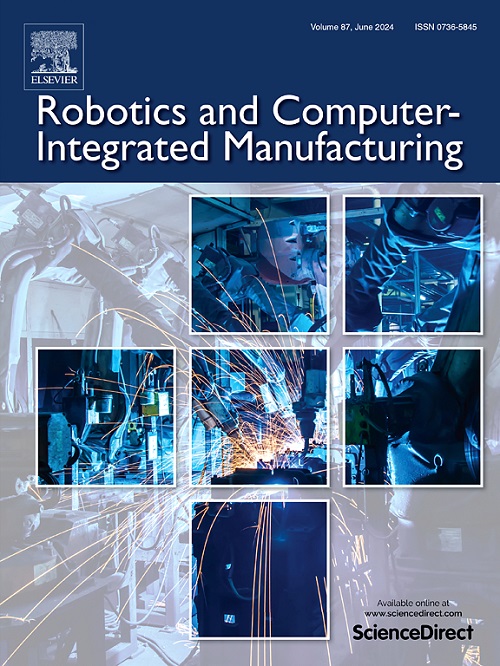面向工业5.0的探测ar辅助无缝HRC装配:多模态相互认知和llm驱动的知识推理
IF 11.4
1区 计算机科学
Q1 COMPUTER SCIENCE, INTERDISCIPLINARY APPLICATIONS
引用次数: 0
摘要
工业5.0的进步促进了以人为中心的制造,旨在提高操作员的福祉和需求。当前装配场景中人机协作(HRC)的研究正逐步向以人为中心的智能制造方向发展,特别是在安全和交互方面。然而,在现有的HRC装配环境中,人与机器人之间的脱节关系在处理复杂的制造任务时提出了挑战。协作机器人通常难以准确理解人类的行为和装配环境,而操作员缺乏对当前装配场景的实时洞察。这种不匹配增加了操作人员的认知和身体负担,最终降低了装配效率和质量。为了解决这一问题,实现HRC无缝装配,本文提出了一种增强现实(AR)辅助的HRC装配方法,该方法将多模态相互认知与大语言模型(LLM)驱动的知识推理相结合。首先,提出了一种基于transformer的HRC场景多模态融合感知方法,克服了当前协作机器人在实时理解和响应人类命令和环境变化方面的局限性。在此基础上,提出了一种以人为中心的人机交互认知与安全框架,以降低交互风险,促进操作者与协作机器人之间的智能共存。其次,提出了基于llm驱动的装配知识推理系统。该系统通过构建具有语义关联和动态更新能力的装配工艺信息模型,为HRC任务提供决策支持,并提供优化的装配计划建议。这种方法有效地利用了人工操作员和协作机器人在执行装配任务时各自的优势。此外,基于ar的HRC装配辅助系统旨在增强装配过程中的视觉指导,同时集成上述功能。最后,在实际装配任务中进行了实际验证。实验结果表明,该方法为HRC装配任务提供了高效、智能和可视化的支持,在提高装配效率和产品一致性的同时,显著降低了操作人员的认知负荷。本文章由计算机程序翻译,如有差异,请以英文原文为准。
Probing AR-assisted seamless HRC assembly for industry 5.0: Multi-modal mutual cognition and LLM-driven knowledge reasoning
The advancement of Industry 5.0 fosters human-centric manufacturing, aiming to enhance the well-being and needs of operators. Current research on Human-robot Collaboration (HRC) in the assembly scene is progressively evolving toward intelligent manufacturing with a human-centric focus, particularly in safety and interaction. However, in existing HRC assembly environments, the disjointed relationship between humans and robots presents challenges in handling complex manufacturing tasks. Cobots often struggle to accurately comprehend human actions and assembly contexts, while operators lack real-time insights into the current assembly scene. This mismatch increases the cognitive and physical burden on operators, ultimately reducing assembly efficiency and quality. To address this issue and achieve seamless HRC assembly, this paper proposes an Augmented Reality (AR) assisted HRC assembly method that integrates multimodal mutual cognition with Large Language Model (LLM) driven knowledge reasoning. Firstly, a Transformer-based multimodal fusion perception method for HRC scenarios is proposed to overcome the limitations of current cobots in understanding and responding to human commands and environmental changes in real-time. Based on this, a human-centric mutual cognition and safety framework for HRC is proposed to mitigate interaction risks and promote intelligent coexistence between operators and cobots. Secondly, an LLM-driven assembly knowledge reasoning system is proposed. By constructing an assembly craft information model with semantic associations and dynamic updating capabilities, the system facilitates decision support for HRC tasks and provides optimized assembly plan recommendations. This approach effectively leverages the respective advantages of human operators and cobots in executing assembly tasks. In addition, an AR-based HRC assembly assistance system is designed to enhance visual guidance during the assembly process while integrating the functionalities above. Finally, practical validation is conducted in real-world assembly tasks. Experimental results demonstrate that the proposed method offers efficient, intelligent, and visualized support for HRC assembly tasks, significantly reducing the cognitive load on operators while improving assembly efficiency and product consistency.
求助全文
通过发布文献求助,成功后即可免费获取论文全文。
去求助
来源期刊
CiteScore
24.10
自引率
13.50%
发文量
160
审稿时长
50 days
期刊介绍:
The journal, Robotics and Computer-Integrated Manufacturing, focuses on sharing research applications that contribute to the development of new or enhanced robotics, manufacturing technologies, and innovative manufacturing strategies that are relevant to industry. Papers that combine theory and experimental validation are preferred, while review papers on current robotics and manufacturing issues are also considered. However, papers on traditional machining processes, modeling and simulation, supply chain management, and resource optimization are generally not within the scope of the journal, as there are more appropriate journals for these topics. Similarly, papers that are overly theoretical or mathematical will be directed to other suitable journals. The journal welcomes original papers in areas such as industrial robotics, human-robot collaboration in manufacturing, cloud-based manufacturing, cyber-physical production systems, big data analytics in manufacturing, smart mechatronics, machine learning, adaptive and sustainable manufacturing, and other fields involving unique manufacturing technologies.

 求助内容:
求助内容: 应助结果提醒方式:
应助结果提醒方式:


